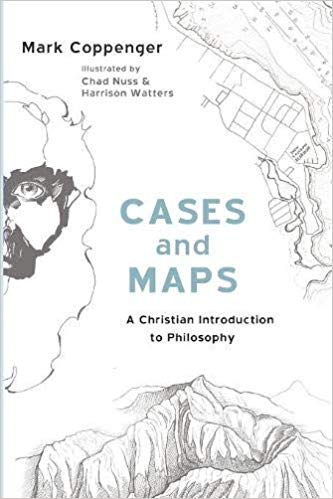A Book Review from Books At a Glance
By Andrew Ballitch
This Christian introduction to philosophy unapologetically focuses on the Western tradition and is self-described as something like “a buffet or tapas, with a little of this and a little of that” (ix). Those of us who have read Mark Coppenger’s previous offering, Moral Apologetics, or had the privilege of sitting in his classroom would expect nothing less. He is more than capable of sustained, methodical argumentation, but often that is not his style. He would rather throw all kinds of seemingly unrelated stuff at you, forcing you to think, and in the end accomplish his purpose, which in Cases and Maps is to introduce diverse philosophical notions, ideas, and concepts from a Christian perspective. It makes his work eclectic, entertaining, and compelling.
The book is split into two equal parts, with twenty-two chapters drawn from case law and twenty-three maps, each individually illustrated by either Chad Nuss or Harrison Watters. The topics are indeed diverse: political philosophy, language philosophy, philosophy of science, philosophy of time, action theory, value theory, justice, divine sovereignty, virtue ethics, existentialism, relativism, idealism, pragmatism, empiricism, to name a few. And with forty-five chapters, Coppenger has to move at a quick clip. And he does so successfully, informatively handling the Hegelian dialectic, for instance, its influence on Marxist materialist politics, and a Christian response in just two pages! Each chapter concludes with a handful of thought-provoking questions aimed at a greater appreciation of the life-importance of philosophy.
Coppenger’s conviction that philosophy is relevant for every-day life motivates his use of case law. Case law can be incredibly taxing on the reader, while at the same time fascinating. Coppenger does his readers a great service in distilling it and putting the cookies on the bottom shelf. One example: McGuinn v. Clarke (1989). This case involved original members of the rock band The Byrds. The group launched in 1964 and when it disbanded in 1973, Jim McGuinn was the only remaining founding member. Well, in the 1980s, Michael Clarke who had left the band in 1967 used the name The Byrds for his new band. So McGuinn and others did a retaliatory reunion tour and a lawsuit ensued. Who were The Byrds in 1989? Coppenger uses this as a springboard into a discussion of the philosophical debate over the essential properties of things. He gives a brief history of the dispute from antiquity through the modern period. One of the chapter’s concluding questions again makes the philosophical debate concrete. He recounts when Texas Governor George Bush refused to stay the execution of brutal pickax murderer Karla Faye Tucker. Many wanted him to reconsider because she became a Christian in prison and was not the same person who committed the atrocity. How are we to think about such a plea?
A representative example of how maps are connected to Christian puzzles and perspectives is the floor plan of the performing arts theater in Ashville, North Carolina. The map illustrates the appropriateness of privacy and persona. Without a backstage, everything the audience sees is a stage and the play is ruined. In life, we need privacy, space to let our persona down. Persona is good and necessary. A baby cries when it feels like it, while an adult can be pleasant when he’s crying inside. This isn’t phony, its maturity and decorum. But imagine a world when you always were observed and were never able to relax. This is worthy of consideration in our increasingly technological age.
Where this book suffers is in its accessibility. The chapters are labeled by the name of the case or the map, which provides no indication of the topic discussed. A simple subtitle with the topic would be a significant improvement. The problem is compounded by the absence of a subject index. So the reader is left with no alternative to perusing the book cover to cover and taking detailed notes if the desire is to use it as a reference. Moreover, there are no footnotes or endnotes to point those interested in further exploration to the sources. On a separate note, some degree of overarching and intentional organization would have been helpful, though this may not have been doable given the “tapas” approach.
Weighing its strengths against its weaknesses, Coppenger’s is a helpful and welcome Christian introduction to philosophy. It exposes one to the wide-ranging discipline of philosophy and consistently grounds it in real-world experience. It evaluates from a biblical worldview. And it is well written and attention grabbing. I would recommend it for anyone who desires an initial foray into the world of philosophy and hope to see it utilized in Philosophy 101 courses at confessional institutions of higher education.
Andrew S. Ballitch (PhD, Southern Baptist Theological Seminary) is a pastor at Westwood Alliance Church in Mansfield, Ohio.
